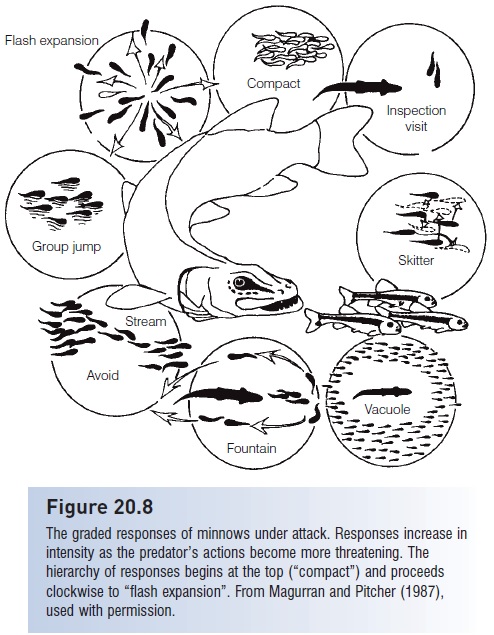Chapter: The Diversity of Fishes: Biology, Evolution, and Ecology: Fishes as prey
Preventing and deflecting attacks - Fishes as prey
Preventing and deflecting attacks
When actually attacked, a prey fish can make a quick evasive move, employ an active defense, rely on passive structural defenses to deflect the predator, or use a combination of actions. Rapid, fast start escape movements that lead to maximal acceleration away from the attacking predator are almost universal among fishes, developing early in the ontogeny of larvae and continuing to function into adulthood relatively unchanged (Webb 1986). Fast start escape movements occur in response to visual, acoustic, tactile, electrical, and water displacement stimuli. The reaction to water displacement is significant since many predators of small fishes use suction feeding, which means that a larva would experience the water around it suddenly moving toward a predator. Anatomical and behavioral features of this escape response indicate that it operates near the physical and temporal limits of nerve conduction and muscle contraction, emphasizing the importance of predation during early life as well as later in most fishes.
Responses of aggregated prey
Shoals under attack perform a series of identifiable maneuvers, elements of which have been noted for groups of minnows and shiners (Cyprinidae), Yellow Perch (Percidae), snappers (Lutjanidae), and sand lances (Ammodytidae), among others (Pitcher & Parrish 1993). The tactic employed is dependent on the type of predator and the intensity of its attack (Fig. 20.8). Shoals generally avoid a slowly approaching predator by maintaining about a 5–15 prey body length space between the predator and the group. Often predators will swim slowly through a prey school, at which time the school separates ahead of the predator and then closes back together behind it, basically creating a prey-free vacuole around the predator. The function of the predator’s slow maneuver is unclear; possibly the predator is testing for injured prey or hoping to catch an inattentive individual off guard. In more concerted attacks, prey expand rapidly out from the point of attack, scattering in different directions and fleeing the scene or seeking refuge in nearby structure.

Figure 20.8
The graded responses of minnows under attack. Responses increase in intensity as the predator’s actions become more threatening. The hierarchy of responses begins at the top (“compact”) and proceeds clockwise to “flash expansion”. From Magurran and Pitcher (1987), used with permission.
Group membership may reduce the statistical likelihood of an individual being attacked by a predator, producing a dilution or attack abatement effect. If a predator only consumes one or a few prey once it encounters a group, then the likelihood of any one individual being eaten decreases as group size increases. An additional benefit of grouping includes the passage of information about a predator to individuals unexposed to the predator. This is termed the Trafalgar effect, after the Battle of Trafalgar, when Admiral Nelson sent information through his fleet using flag codes, informing ships on the far side of the fleet about the enemy’s actions (Pitcher & Parrish 1993).
The most widely demonstrated cause of a decrease in predator success is the confusion effect. In studies with Largemouth Bass feeding on minnows, Pike feeding on perch, sticklebacks feeding on water fleas, and jacks feeding on anchovies (Godin 1986; Landeau & Terborgh 1986), it has been shown that predators catch fewer prey from large than from small schools. Success declines because the predator switches targets as it moves through the school, apparently confused by the number of multiple, edible objects moving across its field of vision. Specific behaviors seemingly function to increase confusion. In skittering, as displayed by minnows, an individual accelerates rapidly, rises in the water column, and then quickly rejoins the group. Protean behavior, seen in anchovies and silversides (Engraulidae, Atherinopsidae, Atherinidae), involves quick, uncoordinated up-and-down movements by several adjacent individuals just prior to resumption of polarized schooling. Roll-and-fl ash, often seen in herring (Clupeidae) schools, occurs when an individual rotates on its long body axis and reflects bright sunlight; it then returns to a normal upright position. The eye is quickly drawn to the point of the flash, but the fish seemingly disappears when upright orientation is resumed (a similar distractive function has been proposed for ink-squirting in octopods and squid under attack). The physiological basis of the confusion effect is poorly understood, although it may relate to an “information overload” problem whereby the predator’s capacity for processing information is exhausted by the sheer number of objects in the visual field (Milinski 1990). Both invertebrate and vertebrate predators are subject to the confusion effect, as anyone who has ever attempted to net individual fish from a school in a large aquarium can attest. Not surprisingly, prey fish choose to join the larger of two schools when given an opportunity, and the speed at which this decision is made increases when predators are present (Hager & Helfman 1991).
Related Topics